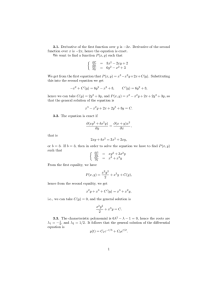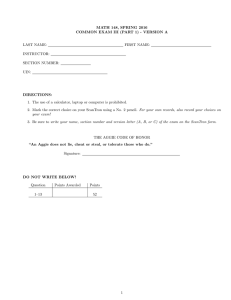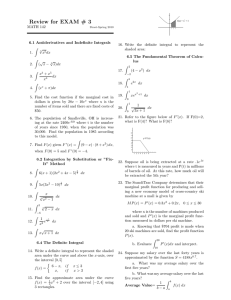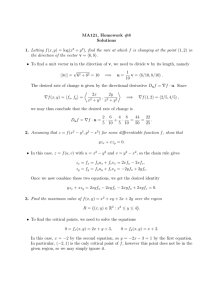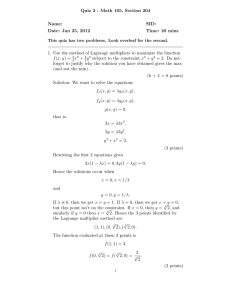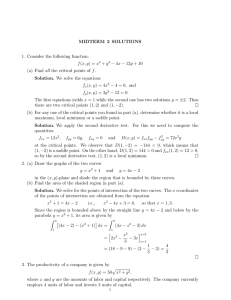1 SOLUTIONS NAME: STUDENT ID NUMBER:
advertisement
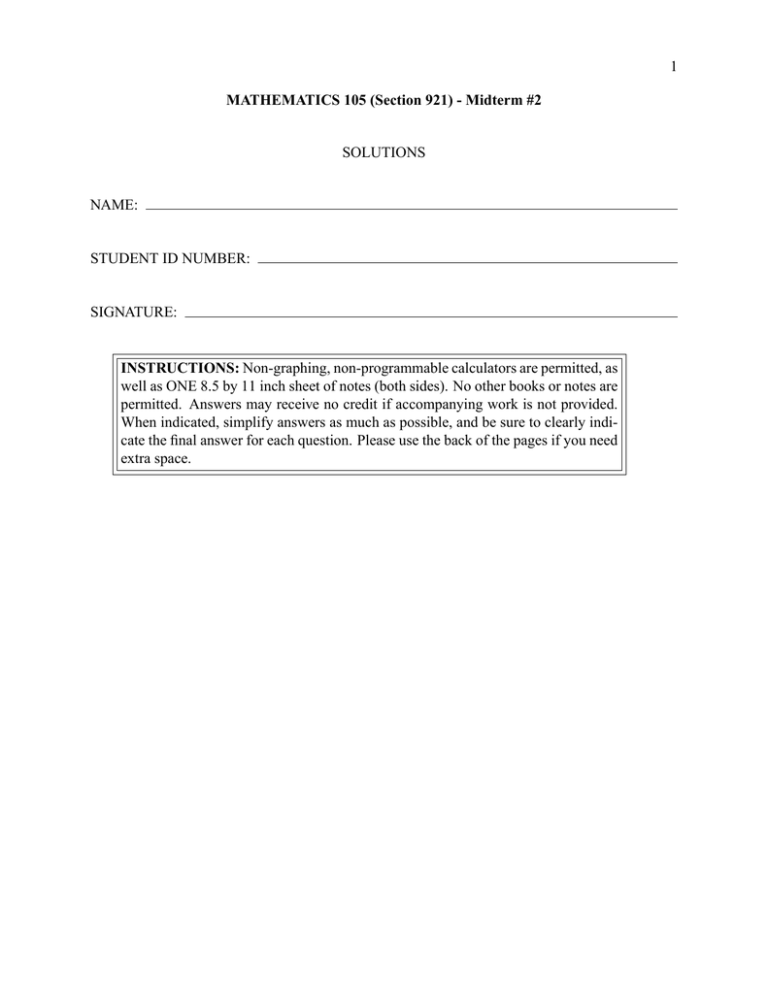
1 MATHEMATICS 105 (Section 921) - Midterm #2 SOLUTIONS NAME: STUDENT ID NUMBER: SIGNATURE: INSTRUCTIONS: Non-graphing, non-programmable calculators are permitted, as well as ONE 8.5 by 11 inch sheet of notes (both sides). No other books or notes are permitted. Answers may receive no credit if accompanying work is not provided. When indicated, simplify answers as much as possible, and be sure to clearly indicate the final answer for each question. Please use the back of the pages if you need extra space. 2 9 1. Find all critical points of f (x, y) = xy(1 − x − y) Determine whether each is a local maximum, local minimum or neither (a saddle point). First, take the first and 2nd derivatives, fx = y(1 − x − y) − xy = y − y2 − 2xy, fxx = −2y, fyy = −2x, fy = x(1 − x − y) − xy = x − x2 − 2xy fxy = (1 − x − y) − y − x = 1 − 2x − 2y Critical points are where fx or fy is undefined (which doesn’t occur here) or when fx = 0 = fy , so we must solve the system 0 = y − y2 − 2xy = y(1 − y − 2x) 0 = x − x2 − 2xy = x(1 − x − 2y) The first equation has solutions y = 0 and y = 1 − 2x. If y = 0, the second equation requires that either x = 0 or x = 1 − 2y = 1. Giving the critical points (0, 0) and (1, 0). If y = 1 − 2x, we sub this into the second equation, we get 0 = x − x2 − 2x(1 − 2x) 0 = −x + 3x2 0 = x(3x − 1) which has solutions x = 0 and x = 13 . Since y = 1 − 2x, the corresponding y-values are y = 1 and y = 31 . Thus, we have the additional critical points (0, 1) and ( 31 , 13 ) We must do the 2nd derivative test to determine the nature of each critical point: D(x, y) = fxx · fyy − ( fxy )2 = −2y(−2x) − (1 − 2x − 2y)2 = 4xy − (1 − 2x − 2y)2 At each critical point we then have D(0, 0) = −(1)2 < 0 D(1, 0) = 0 − (1 − 2)2 < 0 D(0, 1) = 0 − (1 − 2)2 < 0 D(1/3, 1/3) = 4(1/3)2 − (1 − 2/3 − 2/3)2 = 4 1 − > 0. 9 9 So (0, 0), (1, 0) and (0, 1) are neither maxima nor minima (they are saddle points), whereas (1/3, 1/3) is local maximum, since there fxx (1/3, 1/3) = −2(1/3) < 0. 3 11 √ 2. Find the area bounded between the curves y = x 1 − x2 and y = x − x3 √ First, find out where the curves f (x) = x 1 − x2 and g(x) = x − x3 intersect. √ √ Set them equal √ 3 2 2 2 to each other: x 1 − x = x − x gives x( 1 − x − 1 + x ) = 0 so x = 0 or 1 − x2 = 1 − x2 . Square both sides of this to get 1−x2 = 1−2x2 +x4 so x4 −x2 = 0, giving x2 (x +1)(x −1) = 0. So the curves cross each other when x = 0, x = −1 and x = 1. We will therefore be integrating over the subintervals [−1, 0] and [0, 1] To find out which curve is on top, pick a test point in each subinterval: r √ 1 1 3 3 1 1 3 x = − ⇒ f (x) = − =− , g(x) = − + = − 2 2 4 4 2 8 8 So f (x) < g(x) in [−1, 0]. 1 1 x = ⇒ f (x) = 2 2 r √ 3 3 1 1 3 = , g(x) = − = 4 4 2 8 8 So f (x) > g(x) in [0, 1]. Hence, Z 0 Area = −1 x2 [(x − x3 ) − (x p 1 − x2 )]dx + Z 1 [(x p 1 − x2 ) − (x − x3 )]dx 0 0 x4 1 x4 x2 Z 0 p Z 1 p − − − − x x 1 − x2 dx 2 4 −1 2 4 0 −1 0 Z 0 p Z 1 p 1 1 1 1 = − + − − − x 1 − x2 dx + x 1 − x2 dx 2 4 2 4 −1 0 = 1 − x2 dx + 1 du. When x = −1, u = 0, when Make the substitution u = 1 − x2 , so du = −2xdx or dx = − 2x x = 0, u = 1, and when x = 1, u = 0, so 1 1 1 Area = − − − u1/2 du + 2 2 0 Z 1 1 = − + u1/2 du 2 0 i1 1 2h = − + u3/2 2 3 0 1 2 1 = − + = . 2 3 6 Z So the area between the two curves is 16 . Z 0 1 1 − u1/2 du 2 4 11 3. (a) (6 marks) Use the midpoint rule with 5 subintervals to estimate the area between the curves f (x) = ex 2 and g(x) = x over the interval 1 ≤ x ≤ 2. (Do not simplify your answer) For this area, we are estimating the definite integral (check a few points or sketch a graph if you don’t know which one is on the top) Z 2 2 (ex − x)dx 1 First, since n = 5, a = 1, and b = 2, we have ∆x = the sample points x1 = b−a n 1 5 = For the midpoint rule, we must use 13 15 17 19 11 , x2 = , x3 = , x4 = , x5 = 10 10 10 10 10 2 Correspondingly, for the function h(x) = f (x)−g(x) = ex −x we have the function evaluations 11 2 h(x1 ) = e( 10 ) − 13 2 11 13 , h(x2 ) = e( 10 ) − , 10 10 15 2 h(x3 ) = e( 10 ) − 15 , 10 19 2 17 19 , h(x5 ) = e( 10 ) − 10 10 So, the area between the curves over the given interval is approximated by 17 2 h(x4 ) = e( 10 ) − Z 2 1 2 (ex − x)dx ≈ [h(x1 ) + h(x2 ) + h(x3 ) + h(x4 ) + h(x5 )] · ∆x 13 2 11 2 11 13 15 17 19 1 ) ( 10 ) ( 15 )2 ( 17 )2 ( 19 )2 ( 10 10 10 10 − +e − +e − +e − +e − · . = e 10 10 10 10 10 5 = 13.14401272... (b) (5 marks) Find the value of the error bound/error estimate for part (a) 5 The error bound for the midpoint rule is EM ≤ K · (b − a)3 24n2 where in this case we have a = 1, b = 2, n = 5, and K is the maximum value of h00 (x) on 2 2 2 2 [1, 2]. Since h0 (x) = 2xex we have h00 (x) = 4x2 ex + 2ex = 2(2x2 + 1)ex . We’ll look at the 3rd derivative to find out whether h00 (x) has a critical point in [1, 2]. 2 2 2 2 h000 (x) = 8x3 ex + 8xex + 4xex = 4x(2x2 + 3)ex > 0 ∀ x ∈ [1, 2] So h00 (x) is increasing on [1, 2] and so must have its maximum when x = 2. Hence, K = h00 (2) = 2(9)e4 = 18e4 So the error bound is EM ≤ 18e4 (2 − 1)3 3 4 = e = 1.637944501... 2 24(5) 100 6 8 4. Two cars, A and B, have just completed a race (on a fixed racetrack) against each other. It is known that the velocity of car A over the course of the race followed the equation VA (t) = t 3 + 3t 2 + t, whereas the velocity of car B over the course of the race followed 1 1 VB (t) = te− 2 t 2 where t is the time in minutes since the start of the race. If we know the race took exactly 2 minutes, which car won the race? Here we compare the total distances travelled by each car in 2 minutes. Whoever travelled the farthest must have won the race. 2 4 Z 2 Z 2 t2 t 3 3 2 +t + = [4 + 8 + 2] = 14. Dist.A = VA (t)dt = (t + 3t + t)dt = 4 2 0 0 0 1 1 To integrate for car B we will use IBP with u = 12 t, du = 21 dt, dv = e− 2 t dt, v = −2e− 2 t Z 2 Z 2 1 −1t te 2 dt Dist.B = VB (t)dt = 0 0 2 h i Z 2 1 1 2 −te− 2 t + e− 2 t dt 0 0 h i h i2 1 2 −2t − 12 t = −te + −2e = 0 −1 0 −1 = [−2e − 0] + [−2e 4 4 = − +2 = 2− . e e + 2e0 ] Since the distance travelled by car A (14) is greater than that travelled by car B (2 − 4e ) in the total 2 minutes, car A must have won the race. Alternatively, you could compare the average velocities (just 1/2 of each of these values). 7 11 5. In a fair trade market, the demand by consumers for silly putty is believed to be governed by the equation 5x f (x) = 2 (x > 0) 3x + 4x + 1 and the supply of the silly putty by producers is known to follow the equation 5 g(x) = x 8 where x is the quantity of silly putty, f (x) is the demand price, and g(x) is the supply price. Assuming the market price is at equilibrium, find the consumer surplus and the producer surplus. 8 First find the equilibrium point by setting f (x) = g(x) and solving for x. 5x = 3x2 + 4x + 1 5x = 0 = 0 = 0 = 0 = 5 x 8 5 x(3x2 + 4x + 1) 8 15 3 20 2 5 x + x + x − 5x 8 8 8 1 x(15x2 + 20x + 5 − 40) 8 x(3x2 + 4x − 7) x(3x + 7)(x − 1) The only positive solution to this is x = 1, so the equilibrium quantity is xe = 1. Correspondingly, the equilibrium price is pe = g(1) = 85 Now, by the formulae, Z xe CS = 0 f (x)dx − pe · xe = Z 1 5x 0 3x2 + 4x + 1 dx − 1 · 5 8 Use the method of partial fractions to integrate this (noting that 3x2 + 4x + 1 = (3x + 1)(x + 1)) 5x 3x2 + 4x + 1 = A B + 3x + 1 x + 1 Clear the denominator to get 5x = A(x + 1) + B(3x + 1) Putting x = −1 gives −5 = −2B so B = 52 . Putting x = −1/3 gives − 53 = 23 A, so A = − 52 . Hence 5 1 dx 5 1 dx 5 CS = − + − 2 0 3x + 1 2 0 x + 1 8 1 5 5 5 = − ln|3x + 1| + ln|x + 1| − 6 2 8 0 5 5 5 5 5 = − (ln(4) − ln(1)) + (ln(2) − ln(1)) = − ln(4) + ln(2) − . 6 2 6 2 8 Z Z So the consumer surplus is − 65 ln(4) + 25 ln(2) − 58 . Now find the producer surplus PS = pe · xe − So the producer surplus is Z xe 5 16 . 0 5 g(x)dx = − 8 Z 1 5 0 8 xdx = 5 5 2 1 5 − x 0= . 8 16 16 9 This page is intentionally left blank.


